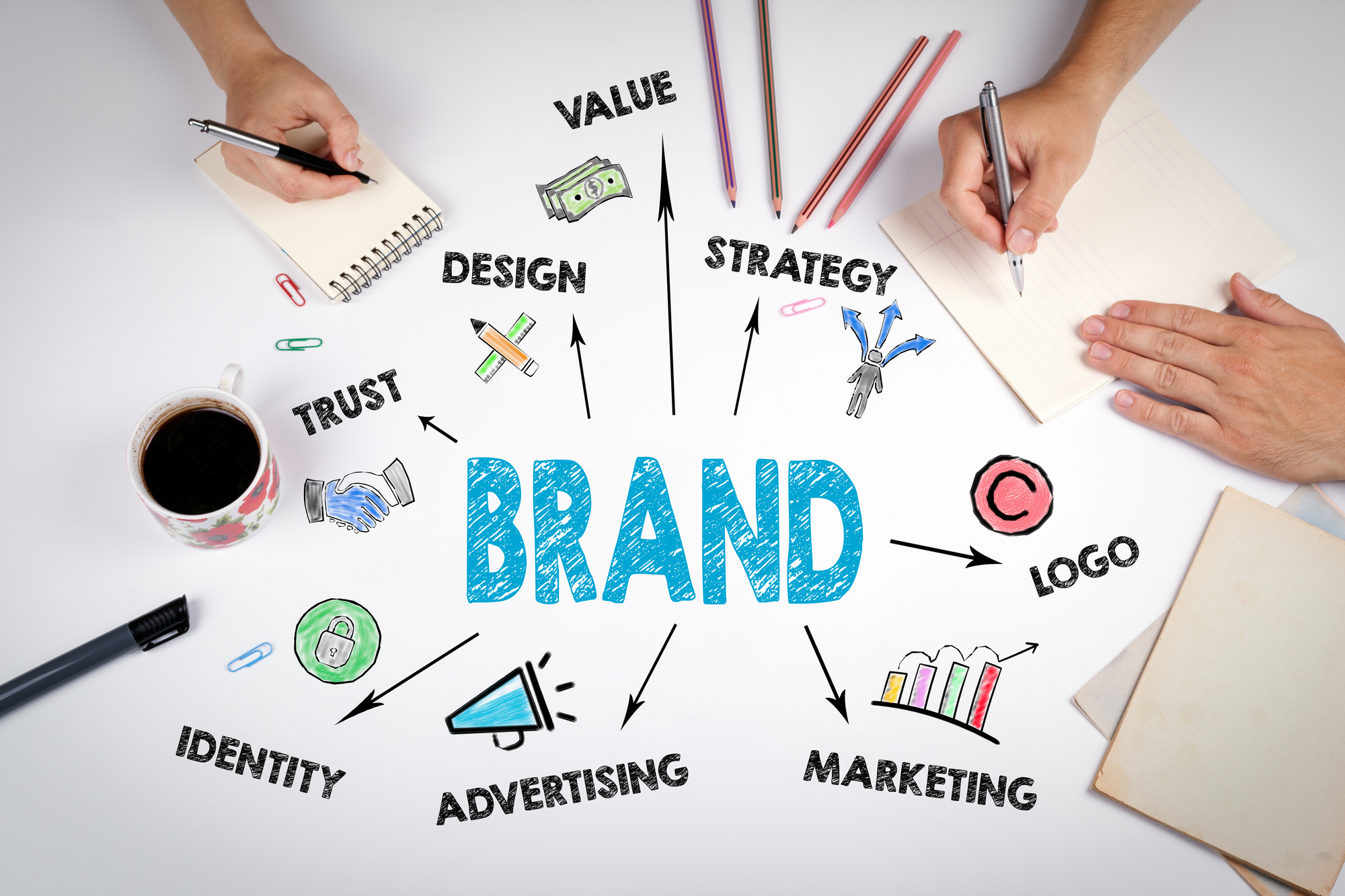Branding Tips: 9 Ways to Help Build Your Brand
Posted on October 14, 2018 by Logo Design Tips and Tricks

What do you think of when we mention the colors red and white along with a family of polar bears? Unless you’ve had your head in the sand for the last half-century, you likely conjured up images of those heartwarming Coca-Cola Christmas adverts.
This, in essence, is what branding is all about. Using as few words or details as possible to create something that sticks in the minds of your customers.
And while we may not be able to help you become the next Coca-Cola or McDonald’s, we can help you understand more about branding practices and the principles behind them.
Ready to take your brand to the next level? Check out these nine awesome branding tips.
1. The Significance of Semiotics
You’ll need to understand the ‘Why’ before you understand the ‘How.’
There’s so much more to branding than awesome logos and catchy slogans. And if you want to create a truly effective branding campaign, you’re going to need to understand that.
That all begins with a quick lesson in semiotics. In short, semiotics is the academic term for the study of signs and signals along with how we interpret them.
Think of a traffic light, for example. The colors red, yellow, and green don’t really mean anything on their own. It’s only when we assign meaning to them — stop, slow down, and go, respectively — that they actually hold a value.
Semiotics and branding go hand-in-hand. Take our Coca-Cola example, for instance! Those colors and images have become synonymous with soda through decades of branding.
But we don’t just know these things. It takes tons of repetition and brand awareness to make these work for you.
2. Call In The SWOT Team
Fortunately, this doesn’t actually involve calling in any sort of militant presence. Instead, it involves you and your team sitting down to take a good hard look at your company’s past and present to determine its future.
SWOT is an acronym for strengths, weaknesses, opportunities, and threats.
The former two are quite self-explanatory, but the latter half of the acronym is where you’ll really start to flex your marketing muscles. Who is your biggest competition and what opportunities are they seizing that your company currently isn’t?
The more you flesh out your company’s standing in the market, the more successful your efforts will be.
3. Analyze Your Values
Whether conscious of it or not, every brand exudes certain values. A surefire way to make branding a business easier is by taking a hold of those values and leveraging them in a positive way.
What is it that you set out to do when you first created your company? Furthermore, what sets you apart from any other business in your field?
Admittedly, these questions can be difficult to answer. However, they’re often actionable responses, such as an increased focus on customer service or an open mind and desire to help the local community as your business grows.
Whatever the case, your brand has values, and you’ll want to make sure they’re sending the right message.
4. Assess Your Audience
Whether you’re in the midst of a campaign that isn’t quite making its mark or you’ve never launched a branding campaign before, you’ll want to take a closer look at your market.
Who, exactly, are you trying to sell your goods or services to and why did you choose that market?
5. Create A Customer Avatar
This step works in perfect tandem with your assessment. Once you have a clearer picture of who you want to sell to, you’ll want to create a fictional individual that exemplifies your audience.
Personifying your audience can make your marketing seem more tangible, in a way, as you’re no longer selling to a faceless group. Now, you’ll have an (albeit fictional) person to market toward.
Include at least basic elements such as their age, gender, income level, language style, and degree of education.
6. Develop Your Brand’s Voice
Branding a business is about setting your company apart from the pack. And part of that includes humanizing yourself, as well as your audience.
One fantastic way to achieve that humanization is to develop a voice for your brand in conjunction with your customer persona.
Speak like your audience speaks. If they’re using casual language, go casual. If you’re trying to sell directly to other businesses, use a more formal, buttoned-up approach.
It is worth noting, though, that warmer language and more personalized content tend to generate better results. So even if you’re a B2B company, try and implement warmer, friendlier language.
7. Make A Memorable Logo
While the more humanistic aspects, such as your brand’s voice and customer persona, matter a great deal, it’s likely your logo that is going to best stick in customers’ minds.
It’s hard to nail down what makes a great logo, but every successful logo has a few things in common:
As you begin to create your logo, think of how you can use each element together to create something your audience will remember.
8. Establish Branding Guidelines
If your marketing team consists of 15 people, and each of those 15 people has their own ideas of what is and isn’t going to help your branding, it’s safe to say that your campaign is going to be quite muddled.
We recommend teams work together to create a set of guidelines and best practices for their personal brand so that branding remains consistent across channels like social media, your website, advertising, and pamphlets.
9. Be Patient
As the saying goes, Rome wasn’t built in a day. And, unfortunately, your branding won’t be, either.
Be patient throughout your campaign and don’t expect results to flood in instantaneously. It’s going to take some time for your efforts to have a noticeable effect.
These Branding Tips Can Make A Corporation A True Brand
These branding tips are designed to give you the basic outline of a strong branding campaign. Now, it’s up to you and your team to create something truly revolutionary!
Ready to get started on your branding? Make sure to check out our free logo-making program that can help you create the next memorable design. And best of all, it’s completely free!
Titillating Travel: 5 Branding Tips for Tourism Companies
Posted on October 04, 2018 by Logo Design Tips and Tricks
With more than 8 million people taking a flight somewhere every day, there are people vacationing and traveling constantly. If you’re trying to compete in the tourism industry, you need to find new ways to brand your company. A few simple branding tips can set you apart from your competitors in an important way.
Here are five ways you could set yourself apart from everyone else in the tourism industry.
1. Be Authentic
When you’re starting a business, you need to deal with the fact that you’re the number one ambassador of your brand. If you’re unhappy or uncomfortable with being out in the public, it’s going to show. If you’re not 100% on board with an idea, people will know.
You need to love the idea of being a travel agent and take your position as the face of the brand seriously.
Use your personality as something to attract people to your company. Show off who you are and what you’re about on Instagram and people will want to go on tours with you for the chance of hanging with you. If you use yourself as one of the attractions for your brand, you get the added bonus of not having to hire another ambassador with also knowing yourself.
If your authentic excitement for tourism comes off in your social media and online profiles, you’ll attract an audience ready to line up for your business.
2. Stay On Message
Every brand needs to have a message and a guiding principle arguing for who they are and what they’re about. When it comes time to give an interview, meet a new client, or talk to a group, you need to always be consistent and on message. If you’re on social media and digital platforms, you need to have the same logo and the same message wherever you go.
It can take years for a brand to take off so don’t be surprised if you need to work hard and repeat your message tirelessly. People may need to see your name and your brand a few times before they’re completely sold on what you’re about.
Every brand on the planet has an ideal customer and an ideal audience. There’s one very specific type of person who your brand is perfect for, and that ideal audience may not be as easy to find as you think. When you stay consistent with your message, you can attract your ideal audience.
Once you’ve attracted them, they will remember you next time they want to travel. They’ll tell their friends how great you are and help to spread the word.
3. Stand Apart From Others
When it comes time to define your tourism business compared to other travel companies, you need to show your uniqueness. It’s essential to show ways that you can impact your clients in a unique way. Your method of doing this should focus on what sets you apart and not what makes you look like every other business.
Give your customers a reason that they should value your brand over others. Figure out what skill you have that other tourism companies don’t have or don’t have time to focus on.
Some tourism companies have a lot of information to offer on their site or while setting up their tour. They might be able to entertain their customers better than other companies by putting together packages that excite and inspire customers.
Think about what you love and what you want from your next tourist trip and offer that to your customers. It’ll be easier for you to communicate with your customers about something you sincerely care about than something you’re still learning about.
4. First Impressions Matter
Remember that in any business, you only get one chance to make a first impression. While you might later decide that you want to rebrand your tourism company, you can only really roll your brand out once. It takes years to build a clientele and if you want to pivot, you’ll have to do so without alienating customers.
If you’re not ready to roll out your brand, take a step back and critique what you want to change. You can’t constantly change your brand without confusing your clients or throwing off your potential clients.
Branding is as important as anything else in business and no changes or movements should be made lightly. Brand yourself once by doing so with a clear message of who you are with a guiding principle, look, and attitude that you’ll feel proud in good times and bad times.
5. Think Two Steps Ahead
Growth is important to any business. When you’re putting together a tourism business, focusing on New York City, Paris, and Jamaica might be the bread and butter of your approach. However, as times change, different cities will meet the needs of a growing audience.
If you’re going to show them Paris, make sure they discover more on your trip.
You need to be constantly looking out for new places your clients will enjoy. If people enjoy working with you once, they’ll want to work with you again, so long as you can always teach them something new.
Stay two steps ahead of your competition by thinking about where your brand will go over time.
Providing every customer with a gift is a great idea so long as you can sustain that cost. If you’ve got 30 clients now, that might not be a big deal. But with 100 clients, you might struggle to keep up with those growing costs.
If you see your competitors tweeting and promoting trips to an emerging locale like Juarez or Berlin, they might have a special deal cut there. Don’t try to compete with them in Berlin. Find your own Berlin deal somewhere where you have connections.
Branding Tips Require Execution
You could have all the smartest branding tips on the planet but they all come down to the unique way you execute them. Without proper execution, you won’t achieve what you want in the industry.
If you want your clients to understand your brand personality starting with your logo, follow our latest guide.
Fashion Branding 101: How to Create a Unique, Bold Fashion Brand
Posted on October 04, 2018 by Logo Design Tips and Tricks

Are you considering launching your own fashion collection or clothing store? If so, you need to learn all about branding if you want your business to stand out from the rest.
Branding is more than just a logo. It’s about the stories you tell, the packaging you use, the quality of your items, and the connection you have with your customers.
Being unique in an oversaturated fashion world is challenging. But if you have an effective marketing strategy and a clear vision, you can compete with worldwide clothing brands.
Keep reading to discover what goes into successful fashion branding and how to implement it in your business.
What Will You Sell?
Rule No. 1 of how to build a clothing brand is to decide whether you’ll be selling ready-to-wear clothes or high-end fashion.
Do you have ambitions to become the hottest new fashion designer or are you happy to offer your creations to a wider audience?
Fashion clothing is about perceived value. Some people buy designer pieces as a status symbol and pay for the brand rather than the actual clothes. Others pay top dollar for haute couture because they feel the quality is higher.
On the other hand, fast fashion clothing brands cater to a crowd that wants to be trendy and doesn’t care about status or designer logos.
Narrow Down the Style
You can build a fashion brand in two ways: one is to design your own clothes for each season and then mass produce them. The other is to curate the best pieces from different manufacturers and sell them year-round.
Whichever you choose, you need to define the style you’ll be going for. Will you be selling classic, timeless pieces or modern, colorful, hip clothes? Are you selling all kinds of sportswear or are you exclusively focused on top-quality yoga pants?
Before you even start a brand, you need to narrow down the style you want to be known for. This is an essential part of your branding that’ll set you apart from your competitors.
Be Devoted to Quality
The most important factor in building a fashion brand is the clothing quality. If you want customers to stay loyal to your brand and tell their friends about it, you can’t compromise on quality.
This is especially true if you want to become a fashion designer with high-paying clients. Well-made clothes are more expensive because they last for years, and the customers get more value for their money.
The quality must be consistent throughout every piece you sell and cannot go down as soon as your business starts growing.
Pick a Name for Your Fashion Brand
When creating a fashion brand, you obviously have to pick a name. You can use your own full name or a variation of it, or think of something catchy and unique to represent your brand values.
Some of the biggest fashion and clothing brands have short, simple, easy-to-remember names. Bear this in mind when you think about the name of your business.
Create a Logo and Unique Packaging
A crucial step in building a clothing brand is creating a unique logo and packaging. This is the visual part of your branding and the first things your customers see when they come across your clothes.
Your logo should be true to your brand vision and represent who you are as a business. The packaging should contain the logo and reflect the experience you want to give to your customers.
Offer Outstanding Customer Service
Your customers are the only reason your brand exists, so you have to treat them with care and respect.
This means providing a smooth shopping experience, seamless returns, and most of all, treating them as a part of a community.
You can do this by sending them discount codes, gifts for their birthdays, loyalty programs, and special offers once in a while.
Use Effective Marketing Strategies
Another golden rule of “How to Build a Fashion Brand 101” is using effective marketing.
This doesn’t mean commercials, large billboards, and flyers. It means connecting to your customers on a deeper level and personalizing their shopping experience.
Show your customers how to style the clothes instead of just displaying a picture of the piece. Show the material up-close, from several perspectives, and in multiple colors.
Invite your customers to share how they wear the clothes and display the photos on your website and social media.
You can also send out newsletters with valuable content, have seasonal giveaways, and use influencers to promote your brand in front of new audiences.
Tell a Story with Your Brand
No matter what type of clothing you sell, you need to establish a gripping story around your brand.
You want customers to recognize your branding without even seeing your logo or packaging. Storytelling is an essential part of your marketing strategy. It’s applicable to everything from your website, product descriptions, emails, social media channels, and company vision.
Blogging is one of the best ways to raise awareness about your brand online and provide value to your customers. You can write about fashion, post lookbooks, talk about beauty, and company news.
To see how other companies use their blog to appeal to their customers, read more here.
Be a Trendsetter
One of the most iconic women in fashion, Coco Chanel, once said that “fashion changes, but style endures.”
Keeping up with the trends is a given in the fashion industry, but even more important is setting them. If you have a fashion brand and you want to make a statement, focus on originality instead of following everyone else.
Be the brand that helps people look and feel unique when wearing your clothes. Don’t settle for the same pieces everyone else is selling. If you want to stand out, be bold and do something nobody else thought of.
Now You Know How to Create Fashion Branding from Scratch
Launching a fashion business is no easy feat and it goes way beyond designing and selling clothes.
Creating a recognizable fashion brand is one of the main factors for the success of your business. Along with having a name, logo, and packaging, fashion branding is also about the stories you tell and your relationship with your customers.
For more branding inspiration and tips, check out our blog.
Need a logo for your business? Now you can create your own logo from scratch using our easy online logo maker.
How to Convey Brand Personality Through a Logo
Posted on August 11, 2018 by Logo Design Tips and Tricks

There are almost 28 million small businesses in the United States. So as a small business owner, you’ve got a lot of competition out there.
Well, one of the best ways to make a lasting impression on your audience is through having a strong logo.
In fact, the best logos showcase your brand’s personality. But it can be hard to make that happen.
That’s why we created this guide to help you portray your brand personality through your logo. Read more below!
The Basics
Let’s start with the basics. What is a logo and why is important? Well, a logo is a brand element that gives a face to your brand.
In other words, it’s your visual identity. It’s a key way for your audience to recognize your company.
Since there is so much competition out there, it’s crucial that you stand out from the crowd. When someone sees your logo, they should understand a little bit about your brand’s personality.
In fact, in many cases your logo is the first impression someone receives about your company. What do you want people to think about you when they see your logo? Thinking through this question will help you develop a logo that correctly conveys your brand values.
It’s easy to wonder why corporations spend so much money on logo creation. Often, companies that have been around a while go through extensive logo updates. This is because industries and trends evolve and change.
Fashion changes over time and so does design. So you should be conscious that your logo is up to date so you don’t come off as outdated or behind the curve.
Next, let’s go over the key parts of your logo.
The Graphic
First, let’s start with the graphic element of your logo. This can be an illustration, an icon, or a pattern. If you think about logos you know, there’s a huge range of graphic elements used.
Apple uses a simple apple as their graphic. Burger King has a burger. Almost every sports team uses a little illustration of their mascot.
Some graphics are more conceptual and less concrete. This could be a pattern or a line.
A great example of this is the Nike swoosh. When taken out of context, the swoosh is just a simple curved line, but now through years of successful branding, the swoosh has come to represent Nike.
The Typography & Font
Fonts can say a lot about your business. Fonts themselves convey feelings and personalities.
For example, Times New Roman is known for being stoic, professional, but also a little boring. Comic Sans, on the other hand, is the classic font for more playful or youthful settings.
Think about your brand values and personality. What adjectives do you want people to use when they describe your company? These answers will help guide your typography choices.
In everything you do with fonts, make sure they’re legible. Also make them unique. Don’t just use a common font that anyone could find in Microsoft Word.
Instead, work to find a unique font that conveys your brand’s personality well.
The Colors
The third and final crucial element of your logo is your color palette. The colors you choose will also convey specific things about your company’s personality. You want to make sure they convey the right things.
Think about the emotions you want people to associate with your brand. It’s simply not enough to choose colors because you like them.
For example, in design blue is often used because it comes across as friendly, authoritative, peaceful, and trustworthy. But every shade of blue is a little different and can mean different things.
At the end of the day, the key here is that you think through your color choice and experiment with different options and combinations before making a final decision.
Need help with your logo design? Check out our online logo maker.
Choose a Design Style that Matches Your Brand Personality
Now that you’ve gone through deciding on graphic, typography, and color, it’s time to put it all together. The most important thing here is that your logo design style matches up with your brand personality.
But the truth is that while this is all great information, it can be hard to know how to move forward without seeing a few examples. So here are some common brand personality traits and brands that you can draw inspiration from.
Simple vs. Complex
Think about the McDonald’s logo. It’s just a simple M. But the key here is that it’s in a unique font that has turned into an iconic symbol.
Their M is so iconic that it even has it’s own name: the golden arches. But at the end of the day, it’s just a letter in a unique font.
On the other end of the spectrum is Unilever. Their logo is also a letter, this time a capital U. But it’s very complex.
Inside it has all types of illustrations and elaborate decorations. This is because Unilever is a large corporation with more than 400 different brands in all types of categories.
Playful vs. Serious
Do you want your brand to come off as playful and fun or serious and experienced? It totally depends on your industry and your brand positioning.
When it comes to playful, Toys R Us is a perfect example. They use a super fun font and bright colors that grab both kids’ and parents’ attention. They also utilize their friendly giraffe mascot often in their branding, which is the perfect graphic element for their lighthearted toy store brand.
Think about most law firms on the other hand. They typically use darker colors in a serif font. This portrays seriousness and expertise.
When you’re in need of a lawyer, you want someone you can trust who knows what they’re doing. You’re paying them a lot of money and you want them to win your case.
So in this case, straightforward, serious branding works perfectly.
Closing Thoughts
Now that you’ve read all about portraying brand personality through logo design, it’s time to try these tips out with your logo!







